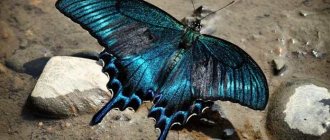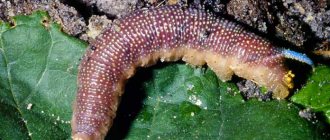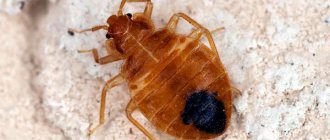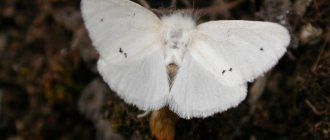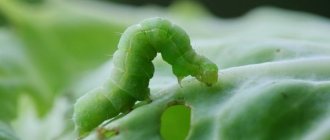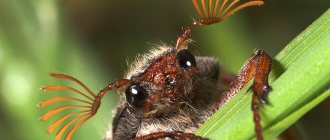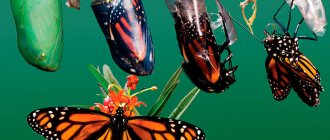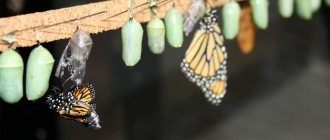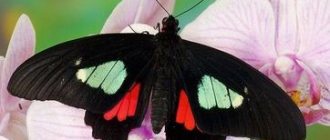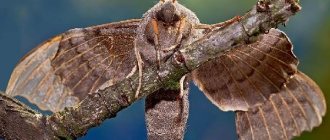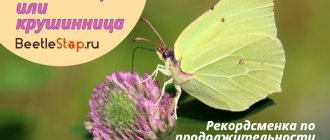Get ready for a journey into the colorful world of insects! You will see unusual butterflies and caterpillars common in the Moscow region, learn to identify them by their external signs and simply get aesthetic pleasure!
When we talk about the benefits of butterflies, we most often mean the properties of adult individuals. Thus, these insects are able to pollinate plants and attract birds to the garden. And if we mention harm, then here we are talking about the caterpillar stage, when the insect actively feeds on plants and can harm garden plantings. The butterflies themselves feed on nectar and are absolutely safe for plant health. Therefore, we will agree in advance that when we call a butterfly “harmful,” we mean its caterpillars.
Now let's take a closer look at the most common fluttering insects that you can find on your site, and determine which of them are useful and which are harmful!
Admiral - butterfly with stripes
Vanessa atalanta, wingspan 50-65 mm
The admiral is easy to recognize: there are red stripes on both sides of his wings. According to one version, it was thanks to this color that the butterfly got its name, because Russian admirals used to have ribbons over their shoulders and red stripes on their trousers. The lower wings of the insect are also decorated with red stripes, on which black dots are clearly visible. The edges of the wings are wavy.
You can meet such a beautiful butterfly not only in Russia, but also in North Africa, North America and even New Zealand. The admiral usually goes to southern countries to spend the winter, but sometimes hides under the bark of trees and remains there until spring. Previously, the admiral was included in the Red Book of Russia, but now the population has recovered.
animalreader.ru
It is not so easy to recognize the admiral's caterpillar as a future butterfly. Dark color, yellow dots on the sides of the body and frightening spikes - the insect is perfectly protected from birds and knows how to camouflage itself. It can be found from May to August on the leaves of nettles, hops and thistles.
How to attract an admiral butterfly. The Admiral loves thistles, asters and blackberries, and at the end of the season he is not averse to eating cracked plums and pears, especially if they have fermented. Place some fruit in a bowl and butterflies will flock to the smell. And to see the caterpillars, plant nettles on the site, which will also be useful as plant food.
The ancient Indians believed that if you catch a butterfly, whisper a cherished wish to it and release it into the wild, it will certainly come true. Try it!
general description
The name admiral appeared due to the similarity of the red stripes on the wings with the admiral's stripes. But there is another version - “admirable” or “wonderful” in English. But the original Latin name is different - Vanessa Atlanta, in honor of the Greek huntress who lived in the forest and ran the fastest.
It is simply impossible to determine the population of the admiral, because the number changes significantly every year. Butterflies do not live long and are highly susceptible to external factors. In addition, the migratory lifestyle complicates any possible calculations. At the moment in Russia the admiral is excluded from the Red Book.
Photo: funart.pro
Hawthorn - beautiful and treacherous
Aporia crataegi, wingspan 50-65 mm
Hawthorn can often be found in gardens in the Moscow region. This beautiful butterfly with white wings decorated with black veins flies from apple tree to rosehip, from rowan to plum, from grape to pear to lay its eggs, from which voracious caterpillars will soon emerge. Hawthorn is a “relative” of the famous cabbage. Prefers wetlands and easily travels long distances in search of food and nesting sites.
nature.baikal.ru
Hawthorn caterpillars are covered with thick hairs and can gnaw an entire bush or tree in a short time. They grow slowly, so they make nests in trees for the winter. If leaves entangled with mulberry threads appear on the branches, rest assured that the hawthorn has settled in your garden!
How to deal with hawthorn and its caterpillars. You can place hunting belts on trees and put up birdhouses to attract birds. In early spring, it is worth spraying the plants with a solution of copper sulfate (100 g per 10 liters of water) with the addition of 500 g of urea. If there are a lot of pests, use insecticides: Alatar, Fatrin, Kinmiks, etc. Carry out the treatment during bud break, when the caterpillars emerge from their winter nests, or in the summer after the caterpillars hatch from their eggs.
Cabbage is a dangerous pest of cabbage heads
Pieris brassicae, wingspan – 45-63 mm
Cabbage grass, or cabbage white, is familiar to every summer resident. You can find it in beds with cabbage, turnips, turnips and other cruciferous crops. The butterfly is fussily looking for a place to lay eggs, from which yellow-green caterpillars will soon appear. During the season, one individual lays up to 300 eggs!
Unprepossessing in appearance, the white hare terrifies with its appearance. You should especially be wary of females, the main difference of which is the black spots on the upper wings.
The voracious caterpillars of the white butterfly eat the leaves and prevent the head of cabbage from forming. After a while, only the veins remain from the leaf. When the food runs out, the pests crawl to new plantings.
How to deal with cabbage and its caterpillars. Safe methods include hand-picking caterpillars and catching butterflies. You can also plant marigolds, marigolds, mint or sage between the rows, which will repel pests. A good way is to cover the cabbage with a mosquito net and agro-canvas so that butterflies cannot lay eggs. Folk remedies will help by spraying 2 tbsp. mustard and 1 tsp. ground red pepper per 10 liters of water. And if there are a lot of insects, use Fitoverm, Karbofos, Actellik or another insecticide.
Harm to plants
Due to its large numbers, strong fertility, polyphagism and the development of at least two generations per season, the American white butterfly is a very dangerous pest.
garden crops. The second and subsequent generations cause the most significant harm.
The caterpillars eat the leaves of rosehip, mulberry, walnut, apple, plum, bird cherry, quince, apricot, pear, peach - a total of more than 200 varieties of herbaceous, tree and shrub plants.
In leaf blades they eat away all the contents between the veins. Also, the leaves are used to make a hair nest.
With a large number of individuals in a population, a group may leave a mature tree completely without leaves. As a result of their activity, the plant is weakened, reducing fruiting and winter hardiness.
Urticaria - a connoisseur of birch sap
Aglais urticae, wingspan – up to 50 mm
You've probably seen this butterfly more than once, but you couldn't even imagine that the offspring of this luxurious beauty feed on stinging nettles! A special sign of urticaria is large black spots on dark orange wings. The hind wings are covered with small blue spots. The insect feeds on nectar of various flowers, and also does not refuse birch sap.
nasekomus.ru
One clutch of wren can contain up to 150 eggs, from which black, hairy caterpillars emerge. They gradually begin to eat the nettles, and at its top they build a nest of cobwebs for shelter from bad weather. After numerous molts, the caterpillar becomes yellow-black and is ready to pupate.
How to attract hives. The answer is obvious - plant nettles! But if you don’t want to see this weed in your summer cottage, try pouring a little birch sap into flat containers to attract insects. And plant lavender, oregano, echinacea, David's buddleia, spirea, bird cherry and other aromatic plants in your flower beds.
- What to plant in a flower garden to fill the garden with an unforgettable aroma
Do you want to plant fragrant flowers on your property? Then take a look at our selection!
Life cycle.
Also on topic:
INSECTS
Night butterflies lay eggs singly or in groups. Females can “shoot” them on the fly, introduce them into plant tissue, or carefully place them on pre-selected objects. The eggs hatch into worm-like larvae - caterpillars - with a clearly distinct hard head, a less prominent chest, bearing three pairs of true jointed legs with a terminal claw each, and an abdomen, on which there are usually five pairs of fleshy false legs, the last one at the very end of the body. The false legs of all butterflies end in several hook-shaped bristles. After several molts, the caterpillars turn into pupae, which in most moths are enclosed in a silk cocoon woven by the larva. Silk is produced by large specialized salivary glands. They secrete a protein-rich liquid that hardens into a fiber when exposed to air. This fiber is used for weaving a cocoon, lining an underground chamber dug by a caterpillar before pupation, building shelters, and also for special methods of protection from enemies. Inside the pupa of evolutionarily advanced taxa, the appendages of the developing adult (imago) are tightly pressed to the body and cannot move. After a certain period of time, depending on the species and external conditions, an adult butterfly emerges from the pupa.
Willow ribbonwort - twilight guest
freenatureimages.eu. Catocala electa, wingspan – 65-88 mm
The second name of this butterfly is willow ribbon. The insect leads a crepuscular lifestyle, so you are unlikely to see it during the day. The butterfly's front wings are gray and inconspicuous, but the lower wings are bright red with black edging and spots in the middle. Moreover, in males the raspberry shade predominates, and in females it is red. The Ribbonwort can also be seen in the fall. It is most often found near bodies of water, in meadows and wetlands. It feeds on tree sap.
pyrgus.de
Caterpillars of the willow tapeworm are perfectly camouflaged. The yellow-gray body is covered with small black dots, the head is brown. The insect feeds on willow and poplar leaves, so it does not harm garden crops. But if you have a willow growing on your site, be vigilant.
How to attract a ribbon girl. It would seem that the insect is nocturnal - why attract it? You can do this at least just to see this amazing butterfly. In the evening, turn on a flashlight or other artificial light source - and the ribbon fly will come to visit you.
Lemongrass is a long-liver in the world of butterflies
Gonepteryx rhamni, wingspan – 52-60 mm
Lemongrass, or buckthorn, is a rather inconspicuous-looking butterfly from the white butterfly family. Small dots are placed in the center of its wings, and the wings themselves imitate the shape of leaves on a tree. Nature has done its best so that these insects can hide from their enemies!
Males have a richer wing color than females. In the latter, the color of the wings is predominantly greenish-white. The development cycle of one individual takes about a year, which is a rare phenomenon in the world of butterflies. Therefore, lemongrass can safely be called a long-liver.
macroid.ru
Lemongrass lays 1-2 eggs on buckthorn leaves. Then green, smooth, slightly flattened caterpillars appear. Despite their great appetite and fastidiousness, insects do not cause much harm to trees.
How to attract lemongrass. Mostly butterflies feed on the nectar of dandelion, meadow cornflower, thistle, but they will not refuse cultivated plants. It is better to fight weeds that attract lemongrass in your summer cottage.
- How to get rid of weeds - the secrets of “clean” beds
Weed control is the main headache of all summer residents. Let’s figure it out together how to suppress the growth of weeds effectively and easily.
How to fight?
So far, there are 2 areas of struggle:
- Use of chemicals;
- Inspection of the area where the pest is believed to be located and its destruction.
The second method is suitable if the area of the site is small, when it is possible to conduct a survey.
The examination is carried out at least once a week; it is not difficult to identify problem leaves: they darken, their edges curl up, as if they are drying up.
It is better to carry out removal in the late afternoon, before dark, by which time the insects gather in their nests. By removing a few leaves, you can get rid of an entire colony. The problem should be solved immediately, before the caterpillars turn into butterflies.
Different preparations are required, depending on what type of plant it is used on and what the characteristics of the soil are.
For example , drugs containing a virus that cause granulosis and nuclear polyhedrosis are used. Their value lies in the fact that insects, in contact with other individuals, spread the disease. Approximately 1/3 of the population dies, the remaining part behaves sluggishly, and the harm from it decreases. In addition, the virus is transmitted to offspring, which encourages developers, because it inhibits the spread of insects.
What can be said about chemicals? Their list is huge, some are suitable for getting rid of various parasites and unwanted guests, others are aimed exclusively against the white butterfly:
- Chlorophos;
- Entobacterin;
- Sevin;
- Rogor;
- Pirinex 40;
- Karbofos;
- Zolon;
- Antio.
Karfbofos, for example, acts on different types of pests, its effect is universal. Antio is also a powerful drug, but its use is harmful to both pets and people.
Research continues, with their help agronomists hope to learn about the pest’s weak points and develop more effective methods.
The problem remains of balancing the use of chemicals and maintaining the purity of products from chemical exposure. It's no secret that insecticides affect people and animals. The presence of chemicals cannot in principle be called normal. After getting rid of an insect, you can become poisoned by the fruits of a tree or plant.
Malinnitsa is a modest record holder
commons.wikimedia.org by Charles J Sharp. Callophrys rubi, wingspan 26-28 mm
The raspberry and the raspberry blueberry are the same butterfly from the genus Greenfinch. It is not easy to notice it, because... the outside of the insect is brown and the inside is green. In addition, the butterfly is small and almost always keeps its wings folded for camouflage. You can meet her not only at the dacha, where she flies for flower nectar, but also in swamps and meadows. Raspberries are common in the temperate zone of Eurasia. The butterfly's habitat reaches the Polar Urals, and in the Alps it sometimes rises to a height of up to 1800 m!
insectamo.ru, author: Ponomarev A. G.
Raspberry caterpillars have a fairly rich “menu”, which includes leaves of blueberry, heather, birch, gorse, buckthorn and other plants. What about raspberries, you ask? Alas, raspberry caterpillars really will not refuse raspberry and currant leaves. But despite their food preferences, they are rare on these plants. Insects are sensitive to chemicals, so they prefer to stay away from summer cottages. In addition, this species is quite rare in nature.
Some blueberry caterpillars are able to pass themselves off as ant larvae. As a result, the ants feed the caterpillars, and the latter, without hesitation, also eat the eggs and larvae of their benefactors.
How to attract raspberries. The raspberry tree is not one of those butterflies that will circle brightly over a flower bed. But if you have clover, sweet peas or vetch, she may come briefly to collect sweet nectar.
Spreading.
Moths are found on all continents except Antarctica and on most oceanic islands. Obviously, the ability of adults to fly has become the most important factor explaining the wide distribution of most species. However, some taxa have different main methods of dispersal. Thus, at high altitudes and in places very remote from the expected hatching areas, young caterpillars were caught traveling through the air on the silk threads they secreted. The spread of species is also facilitated by the attachment of eggs to logs and other objects, which are then transported, for example, by flood waters or wind. Many moths have symbiotic relationships with other species, and their habitats practically coincide with the distribution area of the “hosts”. An example is the yucca moth, which breeds in yucca flowers.
Swallowtail - Queen of Butterflies
Papilio machaon, wingspan – 64-95 cm
It’s hard not to notice such a butterfly! Swallowtail attracts attention with its large size and bright color. The butterfly got its name from the name of a mythological doctor who participated in the Trojan War. A special feature of the swallowtail is the “tails” up to 10 mm in length on the hind wings.
Swallowtail is found all over the world: in Europe, Asia, North America and North Africa. The butterfly population in the middle zone suffers from fires and trampling of meadows. The species is listed in the Moscow Red Book.
The bright swallowtail caterpillars resemble fantastic creatures. Immediately after birth, they begin to feed. In the Moscow region, insects prefer umbrella crops: hogweed, carrots, parsley, fennel and dill. If a caterpillar gets into a garden bed, it can quickly destroy the above-ground parts of the plants. But this happens extremely rarely, because... The swallowtail practically does not fly to summer cottages.
How to deal with swallowtail caterpillars. Carefully remove them and take them outside the site, planting them on some kind of umbrella crop. Be careful, the “horns” of the caterpillars secrete a caustic liquid, so it is better not to pick up the insect with your hands, but tear it off along with a piece of the plant on which it sits.
Maliciousness
Caterpillars of the American white butterfly The insect, a caterpillar of the described species, feeds first on the bark of trees, then on other plants. Older individuals are less demanding of the available food.
Under their influence, the bark of trees is damaged and leaves are destroyed. Plants lose their beauty and weaken under the negative influence of the environment. The tree may even die. As a result, the habitat of animals is narrowed, or at least the condition of the habitat deteriorates.
When the leaves are damaged, the yield decreases by more than 75%, which leads to the death of the crop; a person also suffers from direct contact; the caterpillar can cause an allergic reaction.
Peacock's eye - the most picturesque butterfly of the middle zone
Aglais io, wingspan up to 62 mm
This butterfly will not leave any summer resident indifferent! The insect will decorate any flower garden and its offspring will not cause any harm to the garden. The round spots on the front and hind wings of the butterfly are very reminiscent of the spots on the tail of a peacock. With the help of such a cunning device, the peacock's eye often confuses birds that would like to feast on the butterfly.
dic.academic.ru
The peacock eye caterpillar is not so noticeable, although its black spines can also scare off enemies. Black caterpillars live in large colonies of up to several dozen individuals. They mainly prefer to eat nettles, thistles or hops, and less often – willow and raspberries.
How to attract a peacock eye. These butterflies are excellent pollinators. To attract them to the garden, plant flowers in shades of red, pink, orange or yellow in your flower bed. And also plant some nettles in the area.
How to control peacock eye caterpillars. An invasion of caterpillars can damage the raspberry tree, but if in the spring you treated the plantings with insecticides as standard, do not worry about the safety of the crop. It is easier to remove pest colonies manually.
Mother of pearl - the enemy of apple trees, blackberries and raspberries
Argynnis paphia, wingspan up to 75 mm
The pearlwort is a fairly large daytime butterfly with an unusual spotted color. The name of the insect was given because of the iridescent greenish-silver spots by which butterflies recognize individuals of their species. In warm weather, you can see flocks of pearlworts busily flying over the flower beds. These lepidopterans are also found along roadsides, in clearings and near rivers. There are many subspecies of Argynnis paphia, each of which feeds on specific crops.
molbiol.ru
Most often found in the country are large mother of pearl. Food plants for its caterpillars are apple trees, blackberries, raspberries, and violets. The body of the larvae is covered with many villi.
How to deal with mother of pearl and its caterpillars. There are different ways to protect plants from caterpillars. The simplest is to install trapping belts or pheromone traps and inspect them regularly. Regular removal of curled leaves and attracting birds will also help. It is better to choose biological drugs: Fitoverm, Bitobaxibacillin, Entobacterin, etc.
What harm does it cause to plants?
This polyphagous pest causes damage to more than 200 species of fruit trees and shrubs. He is especially popular with:
- mulberry;
- nut;
- Apple tree;
- pear;
- plum;
- cherry;
- cherries;
- quince;
- apricot;
- peach;
- rose hip.
The damage to trees caused by the butterfly is that:
- Only the newly hatched caterpillars immediately begin to eat the fleshy part of the leaf, leaving only a skeleton of veins. Older individuals eat the entire leaf.
- In the process of life, living in colonies, they form a nest, entwining entire branches, or even the entire tree, with cobwebs.
- The second generation of caterpillars, which is even more numerous, eats fruit crops until autumn.
- Another danger is that these lepidopterans are spreading around the world at tremendous speed, destroying an increasing number of green spaces. And they do this not thanks to their small wings, but by moving in packaging containers, in planting material, in boxes of fruit.
On trees damaged by caterpillars, wood growth slows down.
Metabolic processes in plants are disrupted and protective functions are weakened. As a result of damage, trees may not tolerate frost and die or produce poor yields for several years.
Meadow pestle is a poisonous insect
Zygaenidae, wingspan 16-38 mm
Groups of pests often flutter over flower beds in sunny weather. Insects are easy to recognize: they have rounded red spots on their dark blue or green wings. In addition, unlike other butterflies, the wings of the meadow moth are folded like a roof, like those of moths. If a butterfly is caught, it will begin to secrete repellent foam. In nature, no one hunts a butterfly. It is poisonous and itself very resistant to poisons.
Caterpillars of moths are densely covered with warts, from which small bristles protrude. Body color: yellow-green with a scattering of black spots. Caterpillars can also secrete protective substances, so it is better not to handle insects with your bare hands. They feed mainly on clover and grasshoppers.
How to attract meadow moth. Plant clover, plantain, alfalfa or thyme in the area. The butterfly will also be happy with the dandelion, but usually, on the contrary, they try to remove it from the site.
- How to get rid of dandelions on your property - useful tips for summer residents
Dandelions feel great in your area and threaten to “take over” it completely? Fight the weeds!
Reasons for appearance
Many people wonder where food moths come from in a house where regular cleaning is carried out. She cannot accidentally get into the apartment from the street, since she is not capable of flying that well. Those butterflies that flutter indoors are males. Female moths move much more slowly, mostly hopping from place to place. Therefore, even if a male individual has flown into a dwelling, it will not be able to reproduce without a female one.
Inside the bags there are already eggs or moth caterpillars, which then spread throughout the apartment. They get there through cuts, tears, punctures in the packaging or during packaging of goods at the factory.
Comfortable conditions for the reproduction of food moths are a temperature of 22...25°C and air humidity above 60%.
Burdock - a lover of overseas travel
Vanessa cardui, wingspan 47-65 mm
The burdock butterfly, or thistle, is often confused with the urticaria. They are really similar, but, unlike the urticaria, the burdock is much larger and has black, rather than blue, spots on its hind wings. The number of this species varies from year to year. For example, in 2009 there were especially many of them. For the winter, burdocks fly to North Africa, and then return to the European continent and begin breeding.
wallhere.com
Females lay one egg each on thistle, burdock, coltsfoot, yarrow or nettle. After hatching, the caterpillar makes a shelter out of leaves. Over the course of her life, she can change at least 7 of them. Depending on the food plant, the color of the caterpillars will also change. At the dacha, they will help fight weeds and become food for birds.
In the southern regions of Russia, burdock caterpillars can infect tomatoes, eggplants, soybeans, and melons.
How to attract a burdock. Plant cosmos, asters, saplings, David's buddleia, phlox and other plants attractive to butterflies in your flower beds. Thickets of thistles near the site will also attract the attention of thistles.
Harm to plants
These pests have well-developed jaws and are highly fertile and survivable, which is why they are very dangerous.
The most significant harm to agriculture is caused by the second and subsequent generations of American white butterflies.
Caterpillars destroy the leaves of walnut, mulberry, rose hip, apricot, bird cherry, apple, quince, plum, pear and peach. These pests attack a total of 200 species of trees and shrubs. They eat away all the contents of the leaf blades. In addition, they make nests from leaves.
Growing plants and planting trees is not an easy task, given that nature itself has a negative impact on the fruits of human labor. For example, the American white butterfly
. What is she like?
